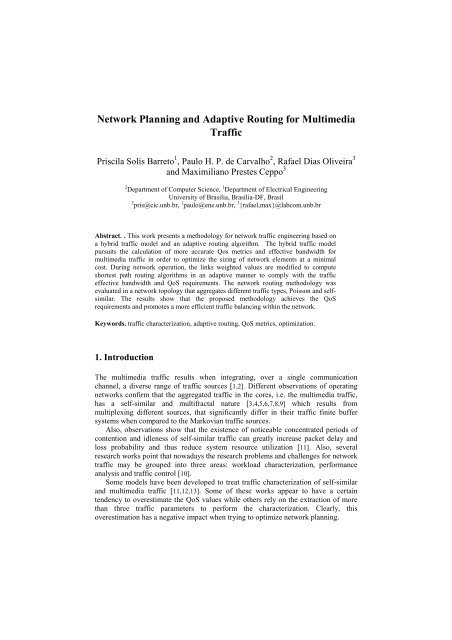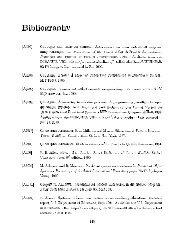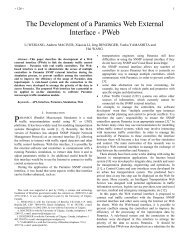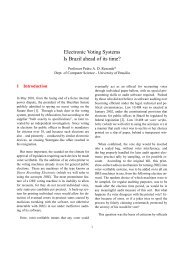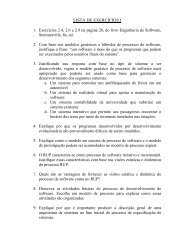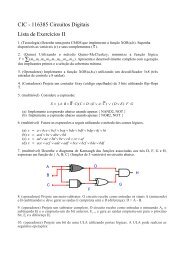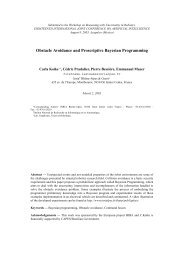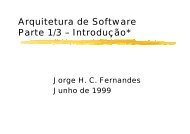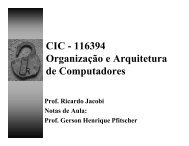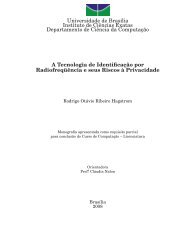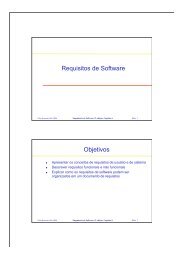Network Planning and Adaptive Routing for Multimedia Traffic - UnB
Network Planning and Adaptive Routing for Multimedia Traffic - UnB
Network Planning and Adaptive Routing for Multimedia Traffic - UnB
You also want an ePaper? Increase the reach of your titles
YUMPU automatically turns print PDFs into web optimized ePapers that Google loves.
<strong>Network</strong> <strong>Planning</strong> <strong>and</strong> <strong>Adaptive</strong> <strong>Routing</strong> <strong>for</strong> <strong>Multimedia</strong><strong>Traffic</strong>Priscila Solís Barreto 1 , Paulo H. P. de Carvalho 2 , Rafael Dias Oliveira 3<strong>and</strong> Maximiliano Prestes Ceppo 32 Department of Computer Science, 1 Department of Electrical EngineeringUniversity of Brasilia, Brasília-DF, Brasil2 pris@cic.unb.br, 1 paulo@ene.unb.br, 3 {rafael,max}@labcom.unb.brAbstract. . This work presents a methodology <strong>for</strong> network traffic engineering based ona hybrid traffic model <strong>and</strong> an adaptive routing algorithm. The hybrid traffic modelpursuits the calculation of more accurate Qos metrics <strong>and</strong> effective b<strong>and</strong>width <strong>for</strong>multimedia traffic in order to optimize the sizing of network elements at a minimalcost. During network operation, the links weighted values are modified to computeshortest path routing algorithms in an adaptive manner to comply with the trafficeffective b<strong>and</strong>width <strong>and</strong> QoS requirements. The network routing methodology wasevaluated in a network topology that aggregates different traffic types, Poisson <strong>and</strong> selfsimilar.The results show that the proposed methodology achieves the QoSrequirements <strong>and</strong> promotes a more efficient traffic balancing within the network.Keywords. traffic characterization, adaptive routing, QoS metrics, optimization.1. IntroductionThe multimedia traffic results when integrating, over a single communicationchannel, a diverse range of traffic sources [1,2]. Different observations of operatingnetworks confirm that the aggregated traffic in the cores, i.e. the multimedia traffic,has a self-similar <strong>and</strong> multifractal nature [3,4,5,6,7,8,9] which results frommultiplexing different sources, that significantly differ in their traffic finite buffersystems when compared to the Markovian traffic sources.Also, observations show that the existence of noticeable concentrated periods ofcontention <strong>and</strong> idleness of self-similar traffic can greatly increase packet delay <strong>and</strong>loss probability <strong>and</strong> thus reduce system resource utilization [11]. Also, severalresearch works point that nowadays the research problems <strong>and</strong> challenges <strong>for</strong> networktraffic may be grouped into three areas: workload characterization, per<strong>for</strong>manceanalysis <strong>and</strong> traffic control [10].Some models have been developed to treat traffic characterization of self-similar<strong>and</strong> multimedia traffic [11,12,13]. Some of these works appear to have a certaintendency to overestimate the QoS values while others rely on the extraction of morethan three traffic parameters to per<strong>for</strong>m the characterization. Clearly, thisoverestimation has a negative impact when trying to optimize network planning.
<strong>Network</strong> <strong>Planning</strong><strong>Traffic</strong>MatrixCharacterizationSizingOptimizationQoS <strong>and</strong> CostRequirementsHybrid <strong>Traffic</strong>Model<strong>Network</strong>Topology<strong>Routing</strong>ModelPer<strong>for</strong>manceEvaluationNewFlowsAdmissionControlMetricsyesOK?no<strong>Routing</strong>Optimization<strong>Network</strong> OperationFig. 1. <strong>Traffic</strong> Engineering FrameworkAs can be seen in Figure 1, the Control Admission procedure relies as well on thePer<strong>for</strong>mance Evaluation procedure. If the QoS requirements <strong>for</strong> that flow can not beachieved, the <strong>Routing</strong> Optimization procedure is triggered <strong>and</strong> the network routingmodel is updated. The variables to implement the methodology are summarized inTable 1.Table 1. Variables <strong>for</strong> <strong>Traffic</strong> engineering with traffic characterizationGivenMinimizeWith thevariablesRestrictionsA network topologyA traffic matrix R HThe cost function <strong>for</strong> link capacitiesd i (C i )A set of traffic trunks defined byFECs=FA cost functionVP R =(L 1 ,L 2 , ....,L b )C=(C 1 , C 2 ,...C n )F L ={(f,l) ∈ M:FVP R }( f , L)< ρ(L)∑ii∀fi∈ ( fi,L),QoSM ( fi,L)≤ QoSR(fi),L∈ VP R <strong>and</strong> exists a f l ∈ F where f i =f lIn Table 1, the QoSR function defines the QoS requirements of a specific serviceclass <strong>and</strong> the QoSM function defines the QoS values of that traffic class when mappedin a VP (virtual path). The QoS parameters are the delay <strong>and</strong> packet loss probability.The ρ(L) function defines the maximum admissible load <strong>for</strong> the link L. The set oftrunks F are the traffic flows grouped by FEC (Forwarding Equivalence Classes)which are mapped in virtual paths when using the function M.Each flow f n is characterized by a group (S,A,P) in which S=(H,a,σ 2 ), with H as theHurst parameter <strong>for</strong> the traffic trace, a is the mean rate <strong>and</strong> e σ 2 is the variance. Theparameters A <strong>and</strong> P are the maximum delay <strong>and</strong> the maximum loss admissible <strong>for</strong> theflow, calculated with function QoSR.
The above definitions induce that, <strong>for</strong> a flow to be associated to a FEC, it shouldcomply the following conditions:(i) ∀ f i ∈ T m ∈ FEC s , Ag H (H i ,T m )
) For a traffic load in the network links lower than 30%, independently of theH value or when the H value is lower than 0.5, the QoS values are calculatedwith the M/M/1/k model, in which k denotes the buffer size.c) For link loads between 30% <strong>and</strong> 100%, the QoS values are calculated with adeterministic fBm envelope divided by the channel capacity c, as proposedin 13.d) For packet loss probability, when it occurs in a node, the traffic flow thatarrives to the following node in the virtual path suffers an influence of thisloss since the H value depends on the value of the aggregated variance. Wepropose the calculus of the media value by preserving the value of thevariance coefficient, which is the relation between the mean value <strong>and</strong>variance.Within the traffic engineering methodology, the routing strategy defines anadaptive dynamic based on effective b<strong>and</strong>width estimation. The effective b<strong>and</strong>width[21,22] definition <strong>for</strong> self-similar flows when characterized as fBm flows [12,13] isshown in (1), with m as the mean, K(H)=H H (1-H) H , a is the variance coefficient, H isthe Hurst parameter <strong>and</strong> P loss is the loss probability with a buffer size b.1 −(1−H ) 11/ H2HH 2HEB = m + K ( H ) − 2 ln Plossa b m(1)Cost calculation Cost calculation Cost calculationEffectiveB<strong>and</strong>widthEffectiveB<strong>and</strong>widthEffectiveB<strong>and</strong>widthInterface 1 Interface 2 Interface N...OSPFSource trafficFig. 2. <strong>Adaptive</strong> <strong>Routing</strong> SchemeIn Figure 2 the adaptive routing procedure is described. While the packets flow inthe different node interfaces, the number of packets during the time interval s as wellas their packet sizes are kept by the effective b<strong>and</strong>width block. In this block, amonitor that tracks the link occupancy returns the link load. Based on the definition ofthe hybrid traffic model described above the values of effective b<strong>and</strong>width arecalculated.After the effective b<strong>and</strong>width calculus, its value is parameter to the OSPF module,which modifies the link cost to the relation (effective b<strong>and</strong>width/link capacity). Thealteration is done simultaneously in all the interfaces. After this alteration, thecommon dynamics of the OSPF algorithm modify the network paths within thenetwork.
Fig. 3. Experimental <strong>Network</strong> TopologyTable 2. <strong>Traffic</strong> flows parametersFlow Source Destiny First H Mean Rate (kBps) VarianceID Node Node Window(kBps)1 1 8 1 0.75 12.5 283542 2 8 11 0.5 8 163753 4 3 1 0.5 10 249894 4 8 11 0.85 7.5 196485 6 3 11 0.60 7.5 92196 7 3 1 0.80 8 48406The results of delay <strong>and</strong> packet losses <strong>for</strong> flow 3 are shown in Figure 6 <strong>and</strong> Figure7 respectively. For both cases, the adaptive routing procedure reduced all the QoSmetrics <strong>for</strong> the flow. In the case of packet loss the reduction is very significantly. Thesame observation appears <strong>for</strong> the flow 6 delay value in Figure 8. For this flow thepacket losses were 0 <strong>for</strong> both cases. The mean jitter <strong>for</strong> flow 6 appears to have alower value <strong>for</strong> the adaptive routing algorithm, as shown in Figure 9.In Table 3 are shown the comparative results <strong>for</strong> mean delay, mean jitter <strong>and</strong>number of packet losses <strong>for</strong> all the flows, <strong>for</strong> the adaptive <strong>and</strong> inverse weighted linkcost. Since the jitter has not been used a restriction metric in our model, its results areused just as a reference variable <strong>for</strong> the other QoS metrics.As can be seen in Table 3,the reduction of packet loss has the most significantly reduction <strong>for</strong> almost all thecases when applied the adaptive routing algorithm. The results are always lower thanthe ones <strong>for</strong> the traditional inverse cost calculus. The mean delay <strong>for</strong> some flowsincrease with the adaptive routing algorithm, but as long as it remains under the QoSlimit value, the result may be considered acceptable.Even when the jitter was not a restriction variable considering in the adaptiverouting process, it can be observed in Table 3 that <strong>for</strong> most of the traffic flows, thejitter was also reduced when applying the proposed methodology.
1.61.4<strong>Adaptive</strong>InverseDelay6050<strong>Adaptive</strong>InversePacket Loss1.2140Value (s)0.8Value300.6200.40.21000 2 4 6 8 10 12 14 16 18 20Window00 2 4 6 8 10 12 14 16 18 20WindowFig. 4. Delay <strong>for</strong> flow 1Fig. 5. Packet losses <strong>for</strong> flow 19080<strong>Adaptive</strong>InversePacket Loss1.41.2<strong>Adaptive</strong>InverseDelay70601Value5040Value (s)0.80.6300.420100.200 2 4 6 8 10 12 14 16 18 20WindowFig. 6. Packet losses <strong>for</strong> flow 300 2 4 6 8 10 12 14 16 18 20WindowFig. 7. Delay <strong>for</strong> flow 30.0560.054<strong>Adaptive</strong>InverseDelay0.01260.01240.0122<strong>Adaptive</strong>InverseJitter0.0520.012Value (s)0.05Value (s)0.01180.01160.0480.01140.0460.01120.0110.0440 2 4 6 8 10 12 14 16 18 20WindowFig. 8. Delay <strong>for</strong> flow 60.01080 2 4 6 8 10 12 14 16 18 20WindowFig. 9. Jitter <strong>for</strong> flow 6
Table 3. Comparative <strong>Traffic</strong> QoS ResultsMean Delay(seconds)Mean Jitter(seconds)Packet Losses(no. of packets)Flow Inv Adap Inv Adap Inv Adap1 0.5846 0.7625 0.0892 0.0329 510 752 0.0489 0.1334 0.0106 0.0121 0 03 0.5353 0.1028 0.1078 0.0116 900 04 0.9922 1.3094 0.1861 0.0859 740 1745 1.0291 0.0716 0.0816 0.0104 240 06 0.0466 0.0445 0.0114 0.0106 0 04. ConclusionsThis article proposed a methodology <strong>for</strong> network planning <strong>and</strong> adaptive routing <strong>for</strong>multimedia traffic. The methodology relies on a hybrid traffic model <strong>for</strong> multimediatraffic. The traffic model characterizes the traffic to produce more accurate QoSmetrics that may be used to optimize the cost of network elements in order to reducethe network planning cost. Within the proposed methodology, the routingoptimization procedure enters in operation when the control admission proceduredetects the impossibility to map a new traffic flow within the established virtual paths.The routing optimization procedure uses an adaptive routing strategy. The adaptiverouting strategy modifies the weighted links costs in a dynamic approach based on theeffective b<strong>and</strong>width necessity. The calculus of the effective b<strong>and</strong>width relies in thehybrid traffic model <strong>and</strong> the OSPF algorithm is used to compute the network paths.The proposed methodology is evaluated in an optimized network with a preestablishedtraffic matrix <strong>and</strong> a pre-defined routing strategy. The results show thatwhen the network is in operation, the adaptive updating of weighted links costs whencompared to the static approach, results in a higher degree of load balancing whichimproves the maintenance of the traffic QoS requirements <strong>for</strong> almost all the traffics.The results were specially improved <strong>for</strong> the packet loss values. The future work ofthis research will evaluate the proposed methodology <strong>for</strong> multifractal traffic.5. References1. Rosen E., Viswanathan A., Callon R. Request <strong>for</strong> Comments: 3031. Janeiro 2001.2. Evans J., Filsfils C. Deploying IP <strong>and</strong> MPLS QoS <strong>for</strong> multiservice networks. ISBN-13:978-0-12-370549-5, Morgan Kaufmann, 2007.3. W. E. Lel<strong>and</strong>, M. S. Taquu, W. Willenger <strong>and</strong> D. V. Wilson. On the self- similar nature ofethernet traffic (extended version). In: IEEE/ACM Trans. on <strong>Network</strong>ing, vol. 2, n. 1, pp.1-15, 1994.4. Park K., Willinger W. Self-Similar <strong>Network</strong> <strong>Traffic</strong> <strong>and</strong> Per<strong>for</strong>mance Evaluation. JohnWiley <strong>and</strong> sons. ISBN: 9780471206446, 2000.5. Sahinoglu, Z. Tekinay, S, On multimedia networks: self-similar traffic <strong>and</strong> networkper<strong>for</strong>mance. In: IEEE Communications, Volume: 37, Issue: 1, pp. 48-52, 1999.
6. Yusheng JI. Multi-Scale Internet <strong>Traffic</strong> Analysis Using Piecewise Self-Similar Processes.In: IEICE Transactions in Communications, E89-B: 2125-2133, 2006.7. Mark E. Crovella <strong>and</strong> Azer Bestavros. Self-Similarity in World Wide Web <strong>Traffic</strong>:Evidence <strong>and</strong> Possible Causes. In: IEEE/ACM Transactions on <strong>Network</strong>ing, Vol. 5, pp.835-846, 1997.8. Rodrigues L, e Guardieiro P. R. A Spatial <strong>and</strong> Temporal Analysis of Internet Aggregate<strong>Traffic</strong> at the Flow Level. In: Global Telecommunications Conference, 2004. Volume 2,pp.: 685 – 691, 2004.9. Carvalho P., Solis P. et al. A <strong>Traffic</strong> Analysis per Application in real IP/MPLS ServiceProvider <strong>Network</strong>”. In: Broadb<strong>and</strong> Convergence <strong>Network</strong>s,. BcN '07. 2nd IEEE/IFIPInternational Workshop, pp. 1-5, 2007.10. Park K., Willinger W., “Self-Similar <strong>Network</strong> <strong>Traffic</strong> <strong>and</strong> Per<strong>for</strong>mance Evaluation”Online ISBN: 9780471206446, 2000.11. Sheluhin O., Smolskiy S., O. Andrew. Self-Similar Processes in Telecommunications.ISBN: 978-0-470-01486-8, Wiley Publishers, 2007.12. Norros I.. On the use of fractional Brownian motion in the theory of connectionlessnetworks. In: Journal on Selected Areas in Communications, 13, pp. 953-962, 1994.13. Fonseca N.L.S., Gilberto, M. e Neto C.A.V. On the equivalent b<strong>and</strong>width of self-similarsources. In: ACM Transactions on Modeling <strong>and</strong> Computer Simulation, 10-2, pp. 104-124, 2000.14. Lee K., Toguyeni A., Noce A., Rahmani A., Comparison of Multipath Algorithms <strong>for</strong>Load Balancing in a MPLS <strong>Network</strong>, Volume3391, pp. 463-470, Lecture Notes inComputer Science, Springer-Verlag, 2005.15. Elwalid A., Jin C., Low S. Widjaja I., MATE: MPLS <strong>Adaptive</strong> <strong>Traffic</strong> Engineering,pp.1300-1309, Infocom 2001.16. B. Fortz, J. Rex<strong>for</strong>d <strong>and</strong> M. Thorup. <strong>Traffic</strong> engineering with traditional IP routingprotocols. In: IEEE Communications Magazine, 40(10):118-124, 2002.17. B. Fortz, M. Thorup, Robust optimization of OSPF/IS-IS weights. Proc. INOC 2003, pp.225-230, 2003.18. Gerla, M. e Kleinrock L. On the Topological Design of Distributed Computer <strong>Network</strong>s.IEEE Transactions on Communications, 25-1, pp. 48-60., 1977.19. Solis Barreto P., de Carvalho, P. H. P., Soares, A. M., Abdalla Jr H. A <strong>Traffic</strong> Model <strong>for</strong><strong>Multimedia</strong> Applications in Converged <strong>Network</strong>s. In: 13th IEEE Modelling, Analysis <strong>and</strong>Simulation in Computer <strong>and</strong> Telecommunications, IEEE Computer Society, 163-170,2005.20. Solis Barreto, P., de Carvalho, P. H. P., Hybrid <strong>Traffic</strong> Model <strong>for</strong> <strong>Multimedia</strong> <strong>Network</strong>Per<strong>for</strong>mance Evaluation. In: AINA - 22nd International Conference on AdvancedIn<strong>for</strong>mation <strong>Network</strong>ing <strong>and</strong> Applications-Workshops, 2008, Okinawa, Japão. IEEEComputer Society, 2008.21. Kelly F.P., Notes on effective b<strong>and</strong>width, in: F.P. Kelly, S. Zachary, I.B. Ziedins (Eds.),Stochastic <strong>Network</strong>s: Theory <strong>and</strong> Applications, Ox<strong>for</strong>d University Press, Ox<strong>for</strong>d, pp. 141-168, 1996.22. Kesidis G., Walr<strong>and</strong> J. Chang S. Effective B<strong>and</strong>widths <strong>for</strong> Multiclass Markov Fluids <strong>and</strong>Other ATM Sources. In: IEEE/ACM Transactions on <strong>Network</strong>ing, vol. 1, No.4, pp.424-428, 1993.23. Solis Barreto P., de Carvalho, et al. Open Source Software <strong>for</strong> Evaluation of Applicationsin an Experimental Testbed <strong>for</strong> Converged <strong>Network</strong>s. TRIDENTCOM 2006. pp. 6, 2006.24. Khanna A., Zinky J. The revised ARPANET routing metric. In: ACM SIGCOMMComputer Communication Review, Volume 19-4, pp.: 45 – 56, 1989.25. Moy J., OSPF Version 2, RFC 2328. Available:: http://www.faqs.org/rfcs/rfc2328.html.Accessed in 14th July 2007.


